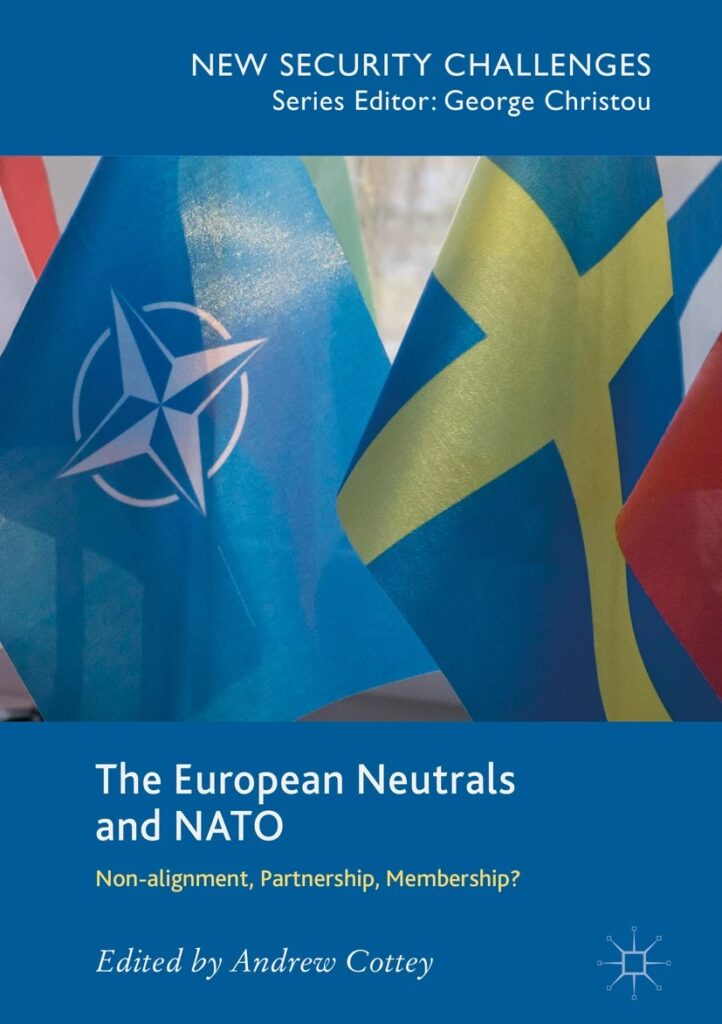
This book provides the first detailed comparative analysis of the unusual partnership between the main European neutral states and NATO. Neutrality and alliance membership are fundamentally incompatible, but through the vehicle of NATO’s post-Cold War partnerships the European neutral states and NATO have found a way to bridge this gap and cooperate with one another. Based on case studies of Austria, Finland, Ireland, Sweden and Switzerland written by leading experts, this book explores the detail of each country’s relationship with NATO, the factors shaping those relationships and whether any of these states are likely to abandon neutrality and join NATO. The book also contributes to broader work on foreign policy by exploring different explanations of the European neutral states’ foreign and security policy choices. This book will be of interest to scholars of the European neutral states, NATO and European security, as well as to those interested in understanding the dynamics behind states foreign policy choices.
- Chapter I: Introduction
- Chapter 2: European Neutrality in Historical Perspective
- Chapter 3: NATO's Partnerships
- Chapter 4: ‘The Allied Partner’: Sweden and NATO Through the Realist–Idealist Lens
- Chapter 5: Finland and NATO: Strategic Choices and Identity Conceptions
- Chapter 6: Austria: Engaged Neutrality
- Chapter 7: Ireland and NATO: Distinctly Low-Profile Partnership
- Chapter 8: Switzerland and NATO: From Non-Relationship to Cautious Partnership
- Chapter 9: The Europe Neutrals and NATO: Future Prospects
Chapter I:
Introduction
Andrew Cottey
This chapter introduces the position of Austria, Finland, Ireland, Sweden and Switzerland as neutral states in European international politics. The chapter examines which European states may be viewed as neutral, noting that Austria, Finland, Ireland, Sweden and Switzerland (along with Yugoslavia) emerged as a distinct group of states outside NATO and the Warsaw Pact during the Cold War. The five states’ status as long-established European democracies but outside NATO now marks them out as unusual in the larger context of European international politics. The chapter also reviews existing academic literature on neutrality and the European neutral states, noting that while quite a lot has been written on the changing character of neutrality and on the impact of European Union membership on Austria, Finland, Ireland and Sweden’s foreign and security policies, the European neutral states’ post-Cold War partnerships with NATO have received less attention. Rear more…
Chapter 2:
European Neutrality in Historical Perspective
Andrew Cottey
This chapter places the neutrality policies of the established European neutral states—Austria, Finland, Ireland, Sweden and Switzerland—in historical context. It explores the origins of neutrality in the idea of non-belligerency in war and the history of neutrality in modern European international politics, highlighting the way in which quite a wide variety of states were or sought to be neutral at various points in the nineteenth century or the first half of the twentieth century. The chapter then shows how the Cold War division of Europe resulted in Austria, Finland, Ireland, Sweden and Switzerland (along with Yugoslavia) emerging as a distinctive neutral group of states between the two blocs. The chapter also reviews how the European neutral states’ foreign and security policies have adapted since the end of the Cold War. It finishes with some conclusions about neutrality in general and the neutrality of the established European neutral states in particular. Rear more…
Chapter 3:
NATO’s Partnerships
Andrew Cottey
This chapter provides an overview and assessment of NATO’s partnerships with non-members. The chapter explores how NATO’s partnerships have evolved from the Partnership for Peace (PfP), established in the early 1990s and targeted primarily at post-communist states in Central and Eastern Europe, to a wider set of partnerships involving not only non-NATO European states, but also Mediterranean and Middle Eastern states and a group of global partners, as well as partnerships with other international organisations (in particular the United Nations, the European Union, the Organization for Security and Cooperation in Europe and the African Union). The chapter explores the complex institutional architecture which NATO has put in place to support its partnerships, as well as the relationship between partnership and NATO enlargement. The chapter identifies four general roles which NATO plays—defence, collective security, cooperative security and integration—and discusses how NATO’s partnerships interact with the Alliance’s wider roles and identity. Rear more…
Chapter 4:
‘The Allied Partner’: Sweden and NATO Through the Realist–Idealist Lens
Magnus Petersson
During the Cold War, Sweden was secretly integrated in Western defence planning. Since then, Sweden has become one of NATO’s most eager partners, cooperating with the organisation to such a large extent that it is informally referred to as NATO’s ‘allied partner’ or ‘partner number one’. Sweden has contributed greatly to all major NATO operations (Bosnia, Kosovo, Afghanistan and Libya), even more so than many NATO members, and during the 2014 NATO summit in Wales signed an agreement on ‘host nation support’ and received special partner (‘gold card’) status within NATO. Despite this, NATO membership is not politically realistic. The reason is a deeply rooted realist scepticism among the Swedish people against joining military alliances combined with a neutralist, idealist identity. Rear more…
Chapter 5:
Finland and NATO: Strategic Choices and Identity Conceptions
Thomas Forsberg
This chapter explores Finland’s relationship with NATO, analysing the evolution of the relationship since the Cold War, as well as the ongoing political debate over joining the Alliance. It argues that psychological factors, identity issues and domestic politics explain the nature of Finland’s policy towards NATO at least as much as geopolitical determinants and strategic calculations based on national interest. The role of the key outside drivers for change in Finland’s policy towards NATO—Russia, NATO itself and the United States, as well as Sweden—are also assessed. The chapter concludes that despite many changes in Finland’s security environment, NATO membership remains only ‘an option’, since domestic politics, identity conceptions and psychological factors all work in favour of policy continuity. Rear more…
Chapter 6:
Austria: Engaged Neutrality
Heinz Gärtner
As a non-NATO state, Austria participates in peace operations and cooperates with NATO while retaining its existing defence policy. Naturally, the fundamental basis of a neutral security policy is avoidance of alliance obligations, including when armed forces are deployed abroad. However, modern neutrality does not exclude cooperation with alliance members or alliances, as long as they can agree on the key issues. Austria shares the basic threat analyses and goals with NATO within the framework of the Alliance’s partnerships, which are not necessarily limited to the institution of Partnership for Peace (PfP). In this partnership context, peace operations are compatible with neutrality. Austria’s ‘engaged neutrality’ means active participation in international security policy in general, and in international peace operations in particular. Rear more…
Chapter 7:
Ireland and NATO: Distinctly Low-Profile Partnership
Andrew Cottey
Cottey assesses the relationship between Ireland and NATO, characterising it as a distinctly low-profile partnership. Irish neutrality emerged in the struggle for independence from Britain, was consolidated in the Second World War and has become deeply embedded domestically since then. When NATO established the Partnership for Peace (PfP) in the 1990s, domestic wariness of the Alliance made Ireland a late-comer in joining the programme. Ireland eventually joined PfP in 1999, driven in particular by NATO’s growing role in peacekeeping (with Ireland contributing forces to the Alliance’s operations in Bosnia and Herzegovina and Kosovo). With NATO’s role in peacekeeping declining, partnership with the Alliance will have less salience for Ireland—although military interoperability with NATO members remains important for the Irish defence forces. Rear more…
Chapter 8:
Switzerland and NATO: From Non-Relationship to Cautious Partnership
Christian Nünlist
In this chapter, Nünlist analyses how Switzerland’s relationship with NATO has changed significantly since 1949. During the Cold War, Switzerland officially pursued a policy of armed neutrality and strict distance from the Western military alliance. In practice, however, we now know that there were sporadic, secret informal contacts with NATO in the early 1950s, in particular with British Field Marshal Bernard L. Montgomery. In the 1990s, Switzerland introduced a new strategy of ‘security through cooperation’ and joined NATO’s Partnership for Peace (PfP) initiative. Since 1999, Switzerland has contributed a military contingent (Swisscoy) to the NATO-led peacekeeping mission in Kosovo. In the twenty-first century, Switzerland’s cautious partnership with the Western alliance has become an accepted normality, even if full NATO membership remains a political taboo. Rear more…
Chapter 9:
The Europe Neutrals and NATO: Future Prospects
Andrew Cottey
This chapter provides an assessment of the partnerships between the European neutral states and NATO since the end of the Cold War. Austria, Finland, Ireland, Sweden and Switzerland’s maintenance of long-standing policies of neutrality reflects a logic of ‘if ain’t broke, don’t fix it.’ A radically changed European security environment and a ‘new’ NATO, however, also led the European neutral states to become proactive partners of NATO. Reflecting their vulnerability to Russia, Finland and Sweden have opted for maximalist policies of ‘everything but membership’. Austria, Ireland and Switzerland’s relations with NATO have been more limited and focused primarily on peacekeeping. As NATO re-focuses on collective defence against Russia, this divergent pattern of partnership with the various European neutral states is likely to be reinforced. Rear more…
